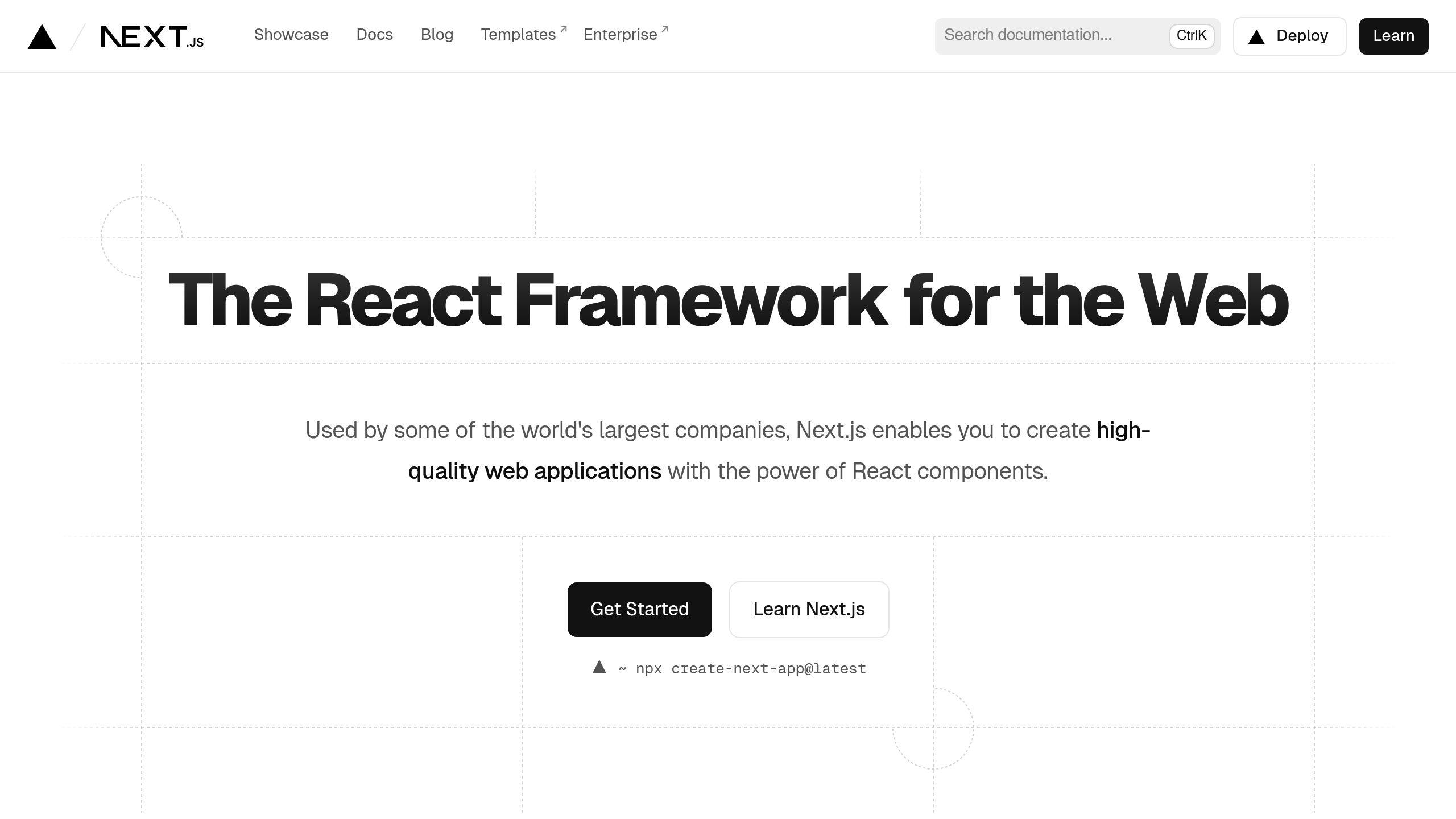Middleware in Next.js acts as an intermediary between incoming API requests and outgoing responses, enabling custom logic for features like authentication, caching, and error handling. By using middleware, developers can:
- Authenticate users before processing requests
- Cache data to reduce API call latency
- Handle errors to prevent application crashes
To optimize your Next.js API with middleware, you'll need:
| Requirement | Description |
|---|---|
| Node.js | Installed on your system to run Next.js applications |
| Next.js | Familiarity with creating pages, API routes, and handling requests/responses |
| JavaScript | Proficiency in JavaScript, as middleware functions are written in JavaScript |
Here's how you can use middleware for API requests:
-
Setting Up Middleware: Create a
middleware.jsormiddleware.tsfile at the same level as yourpagesdirectory. This file will contain the code to run before a request is completed. -
Modifying API Calls: Use middleware to add authentication headers or rewrite/redirect API requests.
-
Caching API Responses: Implement middleware to cache frequently accessed data and reduce API call latency.
-
Handling API Errors: Catch and handle errors with middleware to prevent application crashes and log errors.
To ensure effective and efficient use of middleware, follow these best practices:
- Keep middleware simple and focused
- Use middleware for cross-cutting concerns like authentication and caching
- Avoid chaining multiple middleware functions
- Use the
NextResponseobject to return responses - Test middleware thoroughly with unit and integration tests
How Middleware Works in Next.js

Middleware in Next.js acts as an intermediary between incoming requests and outgoing responses. It enables custom logic to be executed before or after a request is processed, allowing for features like authentication, caching, and error handling.
Middleware Functions
Middleware functions are JavaScript functions that have access to the request and response objects. When a request is made to a Next.js API, these functions are executed in a specific order, creating a chain of middleware functions. Each function in the pipeline can either pass control to the next function or respond to the request directly.
Benefits of Middleware
Middleware enables developers to:
- Authenticate users: Verify user credentials before processing requests
- Cache data: Store frequently accessed data to reduce API call latency
- Handle errors: Catch and handle errors to prevent application crashes
- Implement rate limiting: Prevent abuse and denial-of-service attacks
- Log requests: Log requests and responses for auditing and analytics purposes
By using middleware functions in Next.js, developers can create more efficient, scalable, and secure API endpoints that provide a better user experience.
In the next section, we will explore how to set up and use middleware functions in Next.js applications.
Getting Started with API Optimization
To optimize your Next.js API with middleware, you'll need to meet some technical requirements and have a solid understanding of the basics.
Technical Requirements
You'll need:
| Requirement | Description |
|---|---|
| Node.js | Installed on your system, as it's required to run Next.js applications. |
| Next.js | Familiarity with creating pages, API routes, and handling requests and responses. |
| JavaScript | Proficiency in JavaScript, as middleware functions are written in JavaScript. |
Foundational Knowledge
You should understand:
| Concept | Description |
|---|---|
| API Design | Principles of API design, including RESTful APIs, API endpoints, and request/response cycles. |
| Middleware Concepts | Middleware concepts, such as authentication, caching, and error handling. |
| Next.js API Routes | How to create and handle API routes in Next.js, including using the api directory and exporting API handlers. |
By meeting these requirements and having a solid understanding of the basics, you'll be ready to optimize your Next.js API with middleware.
In the next section, we'll explore how to set up and use middleware functions in Next.js applications.
Using Middleware for API Requests
Let's dive into the practical steps and code examples for setting up and using middleware to manipulate API requests for improved performance.
Setting Up Middleware in Next.js
To set up middleware in Next.js, create a new file named middleware.js or middleware.ts at the same level as your pages directory. This file will contain the code you want to run before a request is completed.
Here's an example of a basic middleware function:
import { NextResponse } from 'next/server';
export function middleware(request: NextRequest) {
// Your middleware logic here
return NextResponse.next();
}
In this example, the middleware function takes a NextRequest object as an argument and returns a NextResponse object. The NextResponse.next() method is used to pass control to the next middleware function or the route handler.
Modifying API Calls
Middleware can be used to modify API requests by rewriting or redirecting them. For example, you can use middleware to add authentication headers to API requests:
| Middleware Function | Description |
|---|---|
authenticateMiddleware |
Checks if the Authorization header is present in the request. If it's not, it redirects the request to the /login page. |
Here's the code:
import { NextResponse } from 'next/server';
export function authenticateMiddleware(request: NextRequest) {
if (!request.headers.authorization) {
return NextResponse.redirect('/login');
}
return NextResponse.next();
}
Caching API Responses
Middleware can also be used to cache API responses to speed up API calls and reduce server load. Here's an example of a middleware function that caches API responses:
| Middleware Function | Description |
|---|---|
cacheMiddleware |
Checks if a cached response is available for the request URL. If it is, it returns the cached response. Otherwise, it passes control to the next middleware function or the route handler. |
Here's the code:
import { NextResponse } from 'next/server';
import { cache } from './cache';
export function cacheMiddleware(request: NextRequest) {
const cachedResponse = cache.get(request.url);
if (cachedResponse) {
return cachedResponse;
}
return NextResponse.next();
}
Handling API Errors
Middleware can be used to catch and handle API errors. Here's an example of a middleware function that catches and logs API errors:
| Middleware Function | Description |
|---|---|
errorMiddleware |
Catches any errors that occur during the request and logs them using a logger function. It then returns a 500 error response with a JSON payload containing the error message. |
Here's the code:
import { NextResponse } from 'next/server';
import { logger } from './logger';
export function errorMiddleware(request: NextRequest) {
try {
return NextResponse.next();
} catch (error) {
logger.error(error);
return NextResponse.status(500).json({ error: 'Internal Server Error' });
}
}
By using middleware to manipulate API requests, you can improve the performance and security of your Next.js API.
sbb-itb-5683811
Best Practices for Middleware
When using middleware in Next.js, follow these best practices to ensure effective and efficient use without sacrificing performance or adding complexity.
Keep Middleware Simple and Focused
- Create simple, single-task middleware functions to avoid complexity.
- Break down complex logic into smaller, reusable functions.
Use Middleware for Cross-Cutting Concerns
- Handle concerns like authentication, caching, and error handling with middleware.
- Centralize and manage these concerns in a single place.
Avoid Middleware Chaining
- Avoid chaining multiple middleware functions to prevent performance issues and debugging difficulties.
- Use a single middleware function or a middleware manager to orchestrate multiple functions.
Use the NextResponse Object
- Return responses to the client using the
NextResponseobject. - Take advantage of Next.js's built-in caching and optimization features.
Test Middleware Thoroughly
- Write unit tests and integration tests to ensure middleware functions work as expected.
- Test middleware thoroughly to ensure performance and security.
By following these best practices, you can ensure effective and efficient use of middleware in your Next.js application.
Conclusion
Optimizing API calls in Next.js using middleware is crucial for building fast, scalable, and maintainable applications. Throughout this article, we have explored the benefits of using middleware in Next.js, including handling cross-cutting concerns, caching API responses, and modifying API calls.
Key Takeaways
By using middleware, developers can:
- Simplify their code
- Improve performance
- Enhance security
Best Practices
To ensure effective and efficient use of middleware, follow these best practices:
| Best Practice | Description |
|---|---|
| Keep middleware simple and focused | Create simple, single-task middleware functions to avoid complexity. |
| Use middleware for cross-cutting concerns | Handle concerns like authentication, caching, and error handling with middleware. |
| Avoid middleware chaining | Avoid chaining multiple middleware functions to prevent performance issues and debugging difficulties. |
Use the NextResponse object |
Return responses to the client using the NextResponse object. |
| Test middleware thoroughly | Write unit tests and integration tests to ensure middleware functions work as expected. |
By following these best practices, developers can ensure effective and efficient use of middleware in their Next.js applications.
In conclusion, middleware is a powerful tool in Next.js, and by mastering its use, we can take our applications to the next level.
FAQs
How to use middleware in Next.js API?
To use middleware in Next.js API, create a file named middleware.ts (or .js) in the root of your project. This file should be at the same level as pages or app, or inside src if applicable. Note that only one middleware.ts file is supported per project, but you can still organize your middleware logic modularly.
What is NextResponse in Next.js middleware?
NextResponse is an API in Next.js that allows you to work with responses in Middleware. It provides methods for:
| Method | Description |
|---|---|
| Redirecting requests | Redirecting requests to a different URL |
| Rewriting responses | Modifying the response content or headers |
| Setting headers | Adding or modifying response headers |
| Setting cookies | Adding or modifying response cookies |
These methods enable you to customize and manipulate responses in your Next.js API.


